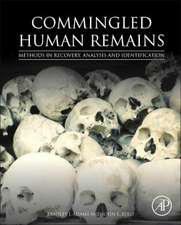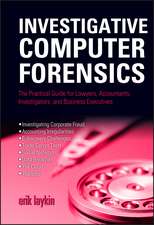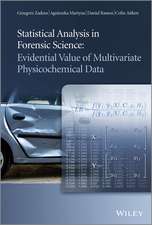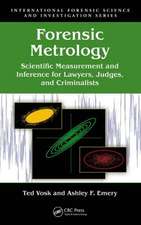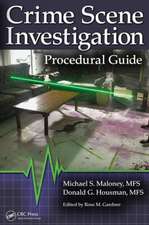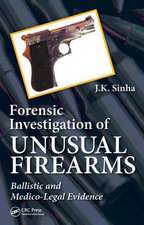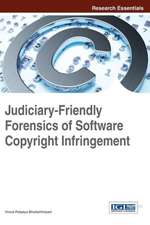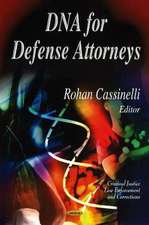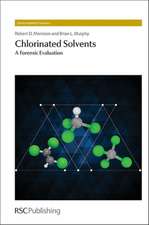Data Mining for Intelligence, Fraud & Criminal Detection: Advanced Analytics & Information Sharing Technologies
Autor Christopher Westphalen Limba Engleză Hardback – 22 dec 2008
Written by one of the most respected consultants in the area of data mining and security, Data Mining for Intelligence, Fraud & Criminal Detection: Advanced Analytics & Information Sharing Technologies reviews the tangible results produced by these systems and evaluates their effectiveness. While CSI-type shows may depict information sharing and analysis that are accomplished with the push of a button, this sort of proficiency is more fiction than reality. Going beyond a discussion of the various technologies, the author outlines the issues of information sharing and the effective interpretation of results, which are critical to any integrated homeland security effort.
Organized into three main sections, the book fully examines and outlines the future of this field with an insider’s perspective and a visionary’s insight.
- Section 1 provides a fundamental understanding of the types of data that can be used in current systems. It covers approaches to analyzing data and clearly delineates how to connect the dots among different data elements
- Section 2 provides real-world examples derived from actual operational systems to show how data is used, manipulated, and interpreted in domains involving human smuggling, money laundering, narcotics trafficking, and corporate fraud
- Section 3 provides an overview of the many information-sharing systems, organizations, and task forces as well as data interchange formats. It also discusses optimal information-sharing and analytical architectures
Preț: 1009.81 lei
Preț vechi: 1262.26 lei
-20% Nou
Puncte Express: 1515
Preț estimativ în valută:
193.22€ • 201.76$ • 159.56£
193.22€ • 201.76$ • 159.56£
Carte tipărită la comandă
Livrare economică 15-29 aprilie
Preluare comenzi: 021 569.72.76
Specificații
ISBN-13: 9781420067231
ISBN-10: 1420067230
Pagini: 448
Ilustrații: 208 black & white illustrations, 25 black & white tables
Dimensiuni: 178 x 254 x 23 mm
Greutate: 1.04 kg
Ediția:New.
Editura: Taylor & Francis
Colecția CRC Press
Locul publicării:Oxford, United Kingdom
ISBN-10: 1420067230
Pagini: 448
Ilustrații: 208 black & white illustrations, 25 black & white tables
Dimensiuni: 178 x 254 x 23 mm
Greutate: 1.04 kg
Ediția:New.
Editura: Taylor & Francis
Colecția CRC Press
Locul publicării:Oxford, United Kingdom
Public țintă
Professional and Professional Practice & DevelopmentCuprins
Overview. The Quality of Data.
What Are Patterns? Border Protection.
Money Laundering and Financial Crimes.
Money Service Businesses. Fraud Analytics.
Information-Sharing Protocols. Information-Sharing Systems. Summary.
What Are Patterns? Border Protection.
Money Laundering and Financial Crimes.
Money Service Businesses. Fraud Analytics.
Information-Sharing Protocols. Information-Sharing Systems. Summary.
Recenzii
"…this book should be mandatory reading for every Crime Analyst. I’ve seen a lot of this info before but never in one place before nor with the level of explanation and examples."
—Michael P. Ley, Antiterrorism Officer (ATO) & Intelligence Coordinator, U.S. Marine Corps Support Facility-Blount Island, Jacksonville, FL, USA
—Michael P. Ley, Antiterrorism Officer (ATO) & Intelligence Coordinator, U.S. Marine Corps Support Facility-Blount Island, Jacksonville, FL, USA
Descriere
Every organization, bureau, agency, and corporation has fundamental analytical needs that traditionally require a significant amount of data integration and resources. Whether investigating money laundering, insider trading, insurance fraud, or terrorist behavior, the analytical processes and systems architectures are very similar. In fact, the types of patterns exposed in one domain can often be translated into another. This book reviews the commonality, framework, and infrastructures necessary to implement complex analytical systems. It addresses analytical approaches, technologies, and methodologies as well as information sharing and the design of today’s fusion centers.

